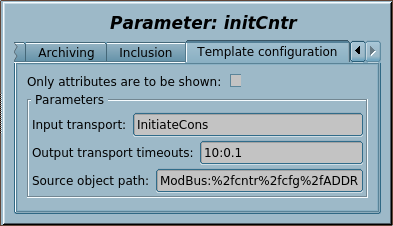From OpenSCADAWiki
Configuring and using
- 1. Create an input transport of receiving the initiative connections of the module "Sockets" with the name like to "InitiateCons".
- 2. Set the previously created transport to the need address of opening the input socket and move it to the mode of creating the associative output transports, leaving the protocol field in empty.
- 3. Provide a container of the data sources to which associative transports must be connected, which can be either a DAQ-module (such as "DAQ.ModBus"), or a logical controller (such as "DAQ.LogicLev.Sources"), or a parameter in it (such as "DAQ.LogicLev.PLC.Sources"), with logical level parameters representing the data source.
- 4. For this template create and run a logical controller object or use any available with the required scheduling properties.
- 5. Create a logical parameter object and select this template for it. Enable the parameter.
- 6. In the tab "Template configuration" of the logical parameter object you need to set:
- Input transport — to value of the identifier of the input transport, created in the item 1, like to "InitiateCons";
- Output transport timeouts — increase the first digit for very slow connections and typical is normal in most situations
- Source objects path — set according to the item 3, for the first part, and to the control field path, for the second part, for example, and typically for for "ModBus", is — "ModBus:%2fcntr%2fcfg%2fADDR".
- 6. RESULT: Starting the controller object (where this parameter was created) and when it was not started, we should get, in the attribute prcTr of the parameter for information about the processed and therefore successfully transport-linked data sources. In case of some violations, we will get the corresponding information in the attribute err of the parameter. The absence of a representative object for the received identifier is placed in the protocol of messages.
